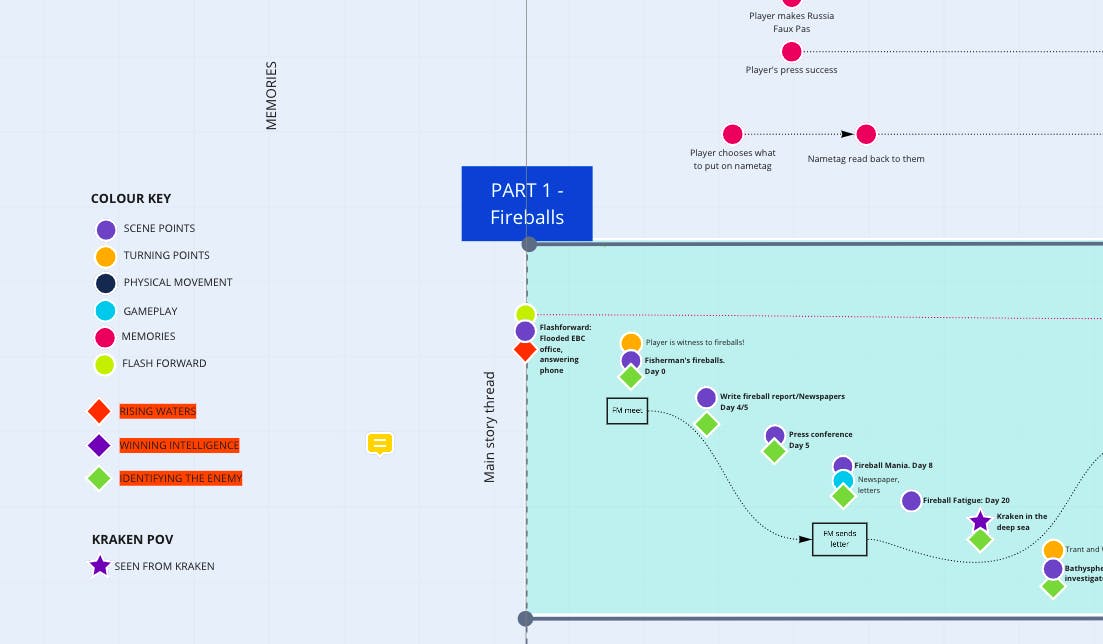Early on in the process of adapting John Wyndham’s much-loved novel The Kraken Wakes into a game, I did what every respectable, trailblazing narrative designer does – googled how to do it. The first result was a Reddit user asking if it is possible for a novel to be “faithfully” adapted into a game, with the top post simply saying: “No. Novels are a linear media”. I quickly closed the browser: we already had the rights from the Wyndham estate!
Being “faithful” to John Wyndham was, of course, at the front of our minds. We love his novels, and we especially love this one. “Do it justice!” “Faithful adaptation!” “Turning in his grave!” – the thoughts rattled. Before I turned into a quivering narrative mess, I reminded myself that our intention wasn’t to be faithful to every aspect of the novel. If so, we would only be recreating it and going to a bewildering amount of effort to get it into Unreal Engine. We instead chose very carefully which aspects to be faithful to. I took stock of what we had in front of us:
1. A compelling and unexpected plot and story world (if anything, too much of it)
2. Fantastic characters (I'd have them round my kitchen table)
3. Relatable themes that provoke genuine emotional responses (yes please!)
PLOT
We have stayed mightily faithful to the plot from the novel. It’s important to note that for this project, we define plot like they do in Dramatica: the things that actually happen, rather than how those things are revealed to the audience. The novel’s plot has been our guiding star through the adaptation process, and despite the game being a greatly interactive and branching experience, the anchoring elements of the plot do not change. We have gone so far as to actively make it clear to a player that in this game, you cannot stop the inevitable “thing” from happening (no spoilers here).

A very, very small section of our giant planning board!
How we reveal that plot, and how the player experiences it, differs greatly from the novel. The novel starts with a flash-forward of Mike and Phyllis together, many years after the beginning of the story. Our game also starts with a flash-forward (great idea, Wyndham!), but an entirely different one, built around our player’s personal story and the desire to onboard them with certain mechanics upfront. We have used methods to express the plot which only games can. In the novel, Mike tells us with his narration how the press react to the content he and Phyllis publish. In the game, our player is put face-to-face with the press at a press-conference alongside Mike and Phyllis, and is expected to decide for themselves how to handle their slew of doubts, demands and scrutiny.
CHARACTERS
Phyllis, Mike, Bocker, Freddy – you’ll meet them. Whether you know Wyndham’s novel or not, we’ve made sure to take the dynamics of these characters that work so well in the book and utilize them in the game. At the very heart of the novel is the dynamic between narrator, Mike, and his much more brilliant wife, Phyllis. We wanted the player to be a part of this, but not as a third-wheel. Instead, we integrated these dynamics into the choices you have in the game: if you want a witty remark or emotional response, go talk to Mike, but if you want to get things done, or need help to decide what to do next, Phyllis is your gal. This is why we didn’t want the player to be Mike, or be Phyllis. We wanted them to experience this story with them.

Mike and Phyllis enjoying a stroll through their garden. Are they holding hands? We like to think so!
There was a fair bit of creative licence used whilst developing the characters. Some were unceremoniously culled, some were painfully merged into one, and, brace yourself, Freddy is a woman. Even dialogue lines from the novel, despite being a gift, were not exempt. We edited heavily, often allocating speech to different characters to get the balance we need.
EMOTIONAL RESPONSES
When I really searched for the essence of this novel, I took into account the multitude of online reviews, I noted my colleague's reactions, and I tuned into general chatter about Wyndham himself. Everything seemed to boil down to how The Kraken Wakes made us feel. It was about relatability, provoked emotions and genuine reactions. And so, every scene, and every mechanic in this game originates from how we are trying to make the player feel.
We took moments from the novel, and interrogated the emotions they evoked. We tried to think back to our first read, and compare that with our second, third, fiftieth. Then, and only then, could we start thinking about how to achieve the same feeling for our player. How can we make the player feel confronted and challenged? How can we make the player feel like the most genius journalist ever? How can we make the player feel a (false) sense of security? Always asking questions like these helped us choose what plot to use and discard, what characters to adjust or kill off. If they were not helping the level achieve the objective feeling, they could go! It greatly influenced our choice of game mechanics, pillars, player positioning, visual styles, music and so on (more on all of that in later blog posts).
We hope, that by staying faithful to the emotional foundations of John Wyndham’s The Kraken Wakes, when the next respectable, trailblazing narrative designer googles “can a novel be faithfully adapted into a game”, the top result is “Yes. Why not?”.
